Abstract
Industrial engineering design is a crucial issue in manufacturing. To meet the competitive global market, manufacturers are continuously seeking solutions to design industrial products and systems inventively. Su-Field analysis, which is one of the TRIZ analysis tools for inventive design problems, has been used to effectively improve the performance of industrial systems. However, the inventive standards used for engineering design are summarized and classified according to a large number of patents in different fields. They are built on a highly abstract basis and are independent of specific application fields, making their use require much more technical knowledge than other TRIZ tools. To facilitate the use of invention standards, in particular to capture the uncertainty or imprecision described in the standards, this paper proposes a rule-based heuristic approach. First, Su-Field analysis ontology and fuzzy analysis ontology are constructed to represent precise and fuzzy knowledge in the process of solving inventive problems respectively. Then, SWRL (Semantic Web Rule Language) reasoning and fuzzy reasoning are executed to generate heuristic conceptual solutions. Finally, we develop a software prototype and elaborate the resolution of “Auguste Piccard’s Stratostat ” in the prototype.
1. Introduction
Industry 4.0 stands for the current trend of digitalization and automation, where manufacturing companies integrate resources vertically and horizontally to achieve better system performance. This digital revolution enables a paradigm shift for companies to leverage advanced techniques, such as artificial intelligence (AI), the Internet Of Things (IOT), and Cyber-Physical Systems (CPSs), to increase productivity and sustainability. To face the competitive global market and increased customer demand, manufacturing companies are continuously searching for optimal solutions for product design and development.
Due to the complex and multidisciplinary nature of the manufacturing industry, how to adopt technological decisions properly in industrial engineering design is a critical concern to manufacturers [1]. In this context, the Theory of Inventive Problem Solving (TRIZ) is a framework that has been pervasively used for problem solving in the industry. TRIZ was proposed by G.S. altshuller in the middle of the 20th century, and its initial goal was to improve and promote the solution of technical problems [2,3]. According to classical TRIZ, the technical systems evolve in similar ways, and by reducing any situation and problem to a physical level, standard solutions and problem solving techniques, borrowed from many different industries, can be applied. In order to also be suited to the complex inventive design problems, several extensions were proposed, such as OTSM-TRIZ or Inventive Design Methodology (IDM) [4,5].
From the TRIZ perspective, for solving industrial engineering problems, the process involves the construction of models and the use of corresponding sources of knowledge. As TRIZ has evolved, various tools have been constructed to facilitate its use in solving design problems, such as the contradiction matrix and 40 inventive principles for eliminating the technical contradictions and 11 separation methods for eliminating the physical contradictions (A technical contradiction arises when it is required to improve some feature of the existing prototype but all solutions known within the domain do not produce the required result or their use would cause a negative effect. A physical contradiction indicates that a part of a design prototype should have two mutually exclusive values of the same physical parameter).
Su-Field analysis is used as an important analytical tool for TRIZ to model a technological issue and to enhance the efficiency of a technological or industrial system. The fundamental idea of the Su-Field model is that any part of a system can be represented as a set of substance (includes typical physical materials (e.g., gas, liquid and solid), interim or composite materials (e.g., aerosol, power, porous)) components and fields (refers to a broad range of energy, including mechanism, chemistry, physics, acoustics, optics and radiations). These components [6] interact with each other. The problem is expressed as an undesirable, inadequate or absent interaction between two components. Obtaining a resolution of the problem implies that the given physical structure containing undesirable or absent interactions must be converted into a structure that obtains the required interactions. G.S. Altshuller [2] proposed a system of 76 inventive standards to instruct which patterns to use to properly convert a given Su-Field model.
Although Su-Field analysis offers an efficient tool for modeling problematic systems and uncovering their problems, the high level of abstraction and indeterminacy in the description of inventive standards often leaves TRIZ users and manufacturers quite perplexed and overwhelmed when looking for conceptual solutions. Cavallucci described the frequency of the main components of TRIZ in the survey of the “Worldwide status of TRIZ perceptions and uses” implemented in 2009 [7], as shown in Figure 1. Based on this figure, we can observe that over three-quarters of the interviewees are aware of Su-Field modeling and inventive standards, while over one half of the interviewees do not actively use them, including the cases of “Just aware of but no usage (L2)”, “Rarely (L3)”, “Sometimes (L4)” and “Only when necessary (L6)”. In contrast to other TRIZ tools, while most interviewees are aware of the Su-Field model and inventive standards, few actively use them, that is, they only use them occasionally when they think it is essential.
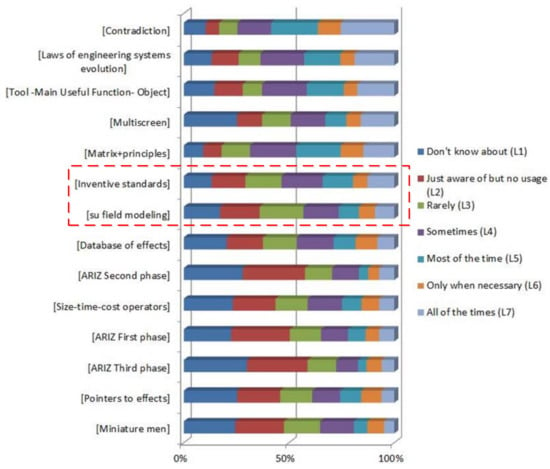
Figure 1.
The frequency of TRIZ’s main components.
This situation is caused by a number of reasons; the high level of abstraction and imprecise description of the inventive standards is one of the most important ones. In a previous work, work [8,9], the development of an intelligent knowledge management system—IngeniousTRIZ—facilitated the process of Su-Field analysis on the basis of inventive principles ontology, the inventive standards ontology and its corresponding SWRL (Semantic Web Rule Language) reasoning. The IngeniousTRIZ system was used to solve industrial engineering problems in an autonomous way. However, these ontologies and rules cannot describe and catch any imprecision or uncertainty that may exist, for instance.
- Inventive Standard 1.1.4: Transition to SFM by using external environment.
- If there is an SFM that is not easy to change as required, and the conditions contain restrictions on the introduction or attachment of substances, the problem has to be solved by synthesizing an SFM using the external environment as the substance.
In Inventive Standard 1.1.4, the subjective word “easy” makes it difficult to determine whether the condition “there is an SFM which is not easy to change as required” is satisfied, and such subjectivity may lead far from the right direction to solve the inventive problem.
To address these issues, in this paper, a rule-based heuristic mechanism is proposed to facilitate industrial engineering design. The contribution of this paper is tri-fold. On the one hand, a fuzzy analysis ontology is built and fuzzy reasoning is conducted to provide users with heuristic inventive standards. On the other hand, SWRL reasoning based on the selected inventive and industrial standards is automatically enforced based on an ontology of Su-Field analysis to produce heuristic abstract solution for specific industrial engineering design problems. At last, an ontology-based system named HeuristicSu-FieldAnalysis is developed to automate and facilitate the inference process for heuristic Su-Field analysis in industrial engineering design.
The remainder of the paper is structured as follows. Section 2 gives a comprehensive review of the similar approaches in industrial engineering design using TRIZ. Section 3 introduces the research foundations and general knowledge of Su-Field analysis for industrial engineering design. Section 4 demonstrates our approach in detail, which includes the construction of knowledge base, the use of logic rules and the implementation of rule-based reasoning for heuristic Su-Field analysis. To evaluate how our proposed approach could facilitate heuristic Su-Field analysis, we present a specific case study in the aerospace industry in Section 5. The Section 6 concludes the paper and outlines future work.
2. Literature Review
In recent years, AI technologies have been pervasively used to solve industrial engineering problems. With the advancement and extensive use of NLP (Natural Language Processing) techniques, knowledge representation and reasoning technologies have been pervasively used in a variety of domains. Ontologies and semantic rules have been jointly used to formally describe a domain of interest and infer new knowledge [10,11,12,13]. Normally, knowledge representation and reasoning approaches can be classified into three categories: distributional semantic representation, model-theoretic semantic representation and frame semantic representation [14].
Considering the specific characteristics of inventive standards and Su-Field modeling, ontology-based modeling methods have been used in this research field. Similar to our work, Yan et al. [8] used ontology to formalize the knowledge of using physical effects in the last step of Su-Field analysis and described the constraint knowledge in SWRL, such as preconditions to use each type of physical effects to instantiate a solution model. In [15], a Su-Field function ontology was developed to formally characterize biomedical information and knowledge. In Bultey et al. [16,17], FOL (First Order Logic) and DL (Description Logic) were used to propose a clarification of the terminology of Su-Field modeling. FOL and DL were also used to facilitate the systematic process of deploying inventive standards. In [9], a system called IngeniousTRIZ was developed. IngeniousTRIZ is an intelligent knowledge management system that performs ontology reasoning to help users retrieve relevant knowledge sources from the built knowledge models.
However, most of the introduced ontological models and logic rules are based on crisp logic and has weakness in expressing imprecision in Su-Field modeling and inventive standards. For example, there is imprecision in the definition of “it’s not easy to change” and “it’s necessary”. To address this issue, the goal of this paper is to study how to enhance ontologies with an ability to express uncertainty and imprecision. Since the idea of fuzzy set and fuzzy logic theory was first proposed by Zadeh [18], various approaches were proposed to try to handle uncertainty within ontologies [19,20]. We sort these contributions into two categories: the first type of methods deal with vague information by providing a procedure information within current standard languages and tools, and the second type of methods that extend current semantic web languages and tools to cope with vagueness. For the first type of methods, Bobillo and Straccia [21] proposed a methodology in which OWL 2 annotation properties were used to extend traditional ontologies into fuzzy ones. In order to support this method, a Protégé plug-in was explored to edit fuzzy ontologies and some parsers were developed to translate the described fuzzy ontologies into the languages supported by some fuzzy DL reasoners. For the second type of methods, Wlodarczyk et al. [22] proposed SWRL-F, which is a fuzzy logic extension of SWRL. SWRL-F extends the functionalities of Protégé and the modified SWRLJessTab (https://protege.stanford.edu/conference/2009/slides/SWRL2009ProtegeConference.pdf accessed on 5 September 2021) with fuzzy logic capabilities. In [23], a fuzzy extention of fuzzy rules (named f-SWRL) was proposed. f-SWRL extends traditional SWRL rules with the ability to perform fuzzy reasoning. Lee et al. [24] proposed an innovative approach combining CBR with TRIZ.Bring them together to generate solutions from the vague, uncertain and open solution space. Wu et al. [25] proposed a new approach to concept design that is based on AD, TRIZ, Fuzzy mathematics and GRA.
Based on the analytics above, to address the aforemention challenges, this paper aims to facilitate the process of Su-Field analysis in industrial engineering design in a more accurate and appropriate way. We first explore the ability to express vague information in industrial domain ontologies of Su-Field analysis. We then extend the fuzzy reasoning abilities of traditional ontologies and rules by using fuzzy knowledge base and fuzzy inference techniques.
3. Su-Field Analysis for Industrial Engineering Design
As one of the most valuable contributions of TRIZ, Su-Field analysis is able to not only model an industrial system in a simple graphical approach and identify problems, but also offer standard solutions to improve the system [26]. Generally, in order to solve a specific inventive design problem, the users start to build a Problem Model, map to a Generic Problem Model, construct a Generic Solution Model based on the inventive standards, and finally choose an appropriate inventive standard to instantiate a Solution Model.
The Su-Field model, including Generic Problem Model and Generic Solution Model, normally consists of two substances and a field. The term is used to represent an object that needs to be manipulated. The term is a tool to act on . Both substances can be as simple as a single element or as complicated as a big system with many components, which can also be explained by individual Su-Field models. The field is the needed energy to enable the interaction between the substances. The states of substances can be typical physical forms (e.g., gas, liquid and solid), interim or composite forms (e.g., aerosol, power, porous). Likewise, the field can refer to a broad range of energy, including mechanism, chemistry, physics, acoustics, optics and radiations. In order to identify problems in a technical system, five types of relationships among the substances, that is, useful impact, harmful impact, excessive impact, insufficient impact and transformation are described [27]. Once a technical system is simplified into a Su-Field model, its potential problems can be identified by analyzing undesired interactions resulted from the model.
To obtain a solution to an inventive design problem, the given physical structure that contains the undesirable interaction has to be transformed into a structure in which the desired interaction is achieved, and 76 inventive standards were explored by G.S. Altshuller based on a huge number of patents to identify these transformations. Inventive standards are built in the form of recommendations, and generally, formulated as rules such as If and then . Both conditions permit recognizing the typology of the problem associated to the standard. This way, for a built problem model, there exist a certain number of recommendations allowing the construction of the corresponding solution model.
Although Su-Field analysis provides a simple means to model engineering systems and uncover their issues, over 70 standard solutions can be quite perplexing and overwhelming for users and manufacturers looking for answers from those many possible solutions. Several categorizations of inventive standards were presented in our previous study [8]: Because Inventive Standard 5.1.1 is divided into 9 separate standard solutions, 76 inventive standards are firstly extended into 84 standard solutions, and then the 84 standard solutions are divided into 4 categories, that is, A-40 inventive standards summarized into 7 generic solutions, B-31 inventive standards defined to be existing inventive principles, C-6 Invention standards regarded as the new invention principles, and D-7 inventive standards derived from evolutionary patterns.
In this work, only standards of categories A (40) and B (31) are continuously studied, and furthermore, according to whether or not there is a fuzzy description in the condition, these are divided into two classes, namely: crisp standards (44) and fuzzy standards (27). The crisp standards allow only the satisfaction or non-fulfillment of conditions, for instance:
- Inventive Standard 5.3.1: Changing of phase state.
- The efficiency of the use of a substance without introducing other substances is improved by changing its phase.
In this case, the condition “without introducing other substances” can be easily identified as to whether it may be true. In comparison, the fuzzy standards allow the condition to be partly satisfied, for instance:
- Inventive Standard 1.1.4: Transition to SFM by using external environment.
- If there is an SFM that is not easy to change as required, and the conditions contain restrictions on the introduction or attachment of substances, the problem has to be solved by synthesizing an SFM using external environment as substance.
In this case, the condition of “there is an SFM which is not easy to change as required” can be identified as being satisfied to a certain extent.
4. Proposed Methods
The proposed heuristic Su-Field analysis method is composed of preprocessing and main processing, as shown in Figure 2.
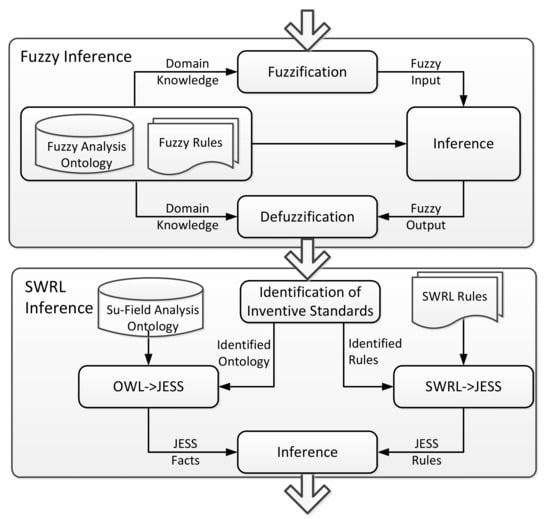
Figure 2.
The architecture of an intelligent system heuristic Su-Field analysis.
The preprocess consists of two stages:
- Stage 1: Build the knowledge base of heuristic Su-Field analysis, consisting of Su-Field analysis ontology and fuzzy analysis ontology. The knowledge base provides foundations for developing intelligent industrial systems.
- Stage 2: Establish SWRL rules and fuzzy rules for reasoning.
The primary process will be performed in the following two stages after preprocessing:
- Stage 1: Fuzzy reasoning is implemented to determine inventive standards.
- Stage 2: SWRL reasoning is implemented to produce heuristic abstract solutions based on the selected or identified inventive standards.
4.1. Construction of Knowledge Base
To realize knowledge reasoning for heuristic Su-Field analysis, this work constructs a knowledge base including Su-Field analysis ontology and fuzzy analysis ontology.
4.1.1. Su-Field Analysis Ontology
Su-Field analysis ontology is built to formalize the crisp terms and relationships appearing in Su-Field analysis. The general terms in this ontology can be specialized into more specific concepts for describing a targeted industry, such as manufacturing, telecommunication, aerospace, transport, etc. As shown in Figure 3,
Problem is a core concept to formally describe Problem Models. When dealing with a real-world case, Problem is linked to Generic_Problem_Model and a Generic_Solution_Model through the two object properties correspondsTo_GPM and
correspondsTo_GSM, respectively. The class
Generic_Problem_Model
has one or two Substances and one
Field, represented by object properties hasSubstance1_GPM, hasSubstance2_GPM and hasField_GPM. The class Generic_Solution_Model uses three object properties hasSubstance1_GSM, hasSubstance2_GSM and hasField_GSM to describe relationships among them. Appropriate InventiveStandard are used for the transformation from Generic_Problem_Model to Generic_Solution_Model. This relationship is described by the object property chooses_IS.
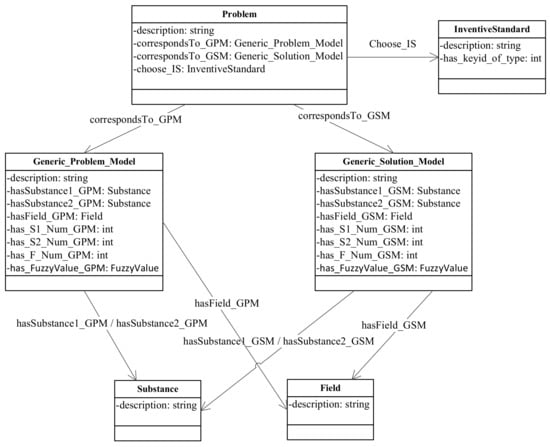
Figure 3.
The framework of the Su-Field analysis ontology.
In order to detect the change in states before and after using InventiveStandard, three properties
has_S1_Num_GPM,
has_S2_Num_GPM and
has_F_Num_GPM are defined to obtain the number of Substances and
Field for Generic_Problem_Model, while three properties has_S1_Num_GSM, has_S2_Num_GSM and has_F_Num_GSM for Generic_Solution_Model.
The two properties has_FuzzyValue_GPM
and has_FuzzyValue_GSM are defined to depict fuzzy information in Generic_Problem_Model
and Generic_Solution_Model, respectively.
4.1.2. Fuzzy Analysis Ontology
Fuzzy analysis ontology is constructed to represent the fuzzy knowledge necessary in Su-Field analysis, where four fundamental fuzzy concepts are defined, namely
FuzzyVariable, FuzzyValue, FuzzySet and FuzzyTerm (http://rorchard.github.io/FuzzyJ/fuzzyJDocs/index.html accessed on 5 September 2021). There is a fuzzy concept defined by FuzzyVariable that provides a name (for instance, possibility), units of the variable if needed, a range of discourse for the variable (for instance, a range from 0 to 100), as well as a set of major fuzzy terms (such as possible, likely, impossible), which will be used to describe the specific fuzzy concept related to
FuzzyVariable. FuzzyValue
depicts a concrete example of the fuzzy concept of
FuzzyVariable, for instance, when indicating the condition “If it is difficult to introduce ferromagnetic or to perform magnetization”, defines the “difficult” FuzzyVariable term “difficulty” and then creates a FuzzyValue by specifying the FuzzyVariable ”difficulty” and a language expression (in the case of ”not easy”).The language expression uses FuzzyTerms defined for FuzzyVariable
and the operators “or” and “and”, with a set of system or user supplied modifiers such as “very”, “not” and “slightly” to form it. The
FuzzySet in a FuzzyValue is the mathematical expression that represents the fuzzy concept of this FuzzyValue. For this work, to define four properties has_FuzzyVariable, has_FuzzyTerm, has_FuzzySet_FT and has_FuzzySet_FV, which represent the relationships between FuzzyVariable and FuzzyValue, FuzzyTerm and FuzzyVariable, FuzzySet and FuzzyTerm, as well as FuzzySet and FuzzyValue.
As illustrated in Figure 4,
FuzzyVariable
is divided into
FuzzyVariable_GPM
and
FuzzyVariable_GSM, and
FuzzyValue
is classified into
FuzzyValue_GPM and
FuzzyValue_GSM, which are represented by the attributes
has_FuzzyValue_GPM and
has_FuzzyValue_GSM and correspond to
Generic_Problem_Model and
Generic_Solution_Model, respectively. Taking into account 27 inventive standards with fuzzy information,
FuzzyValue_GPM
and
FuzzyVariable_GPM
are both separated into 28 subclasses. (There are two fuzzy concepts in
Inventive Standard 4.2.3.) Moreover,
FuzzyValue_GSM
and
FuzzyVariable_GSM
are both divided into 27 subclasses, each subclass corresponding to a fuzzy standard. For simplifying the creation of FuzzySets, a subclass hierarchy is defined [22].
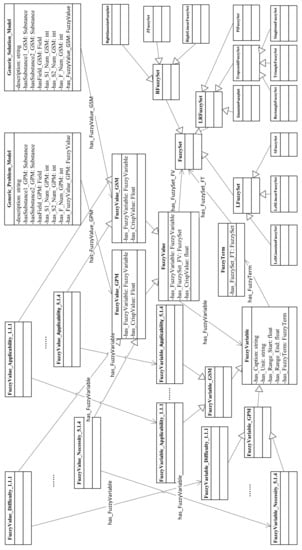
Figure 4.
The framework of the fuzzy analysis ontology.
4.2. Design of Rules
In order to search heuristic abstract solutions for engineering design problems, 27 fuzzy rules are created. These rules aim to process the fuzzy information in the fuzzy standard. In addition, 42 SWRL rules are proposed to reason about the transformation from
Generic_Problem_Model
to Generic_Solution_Model based on InventiveStandards.
4.2.1. Fuzzy Rules
In this work, three sets of
FuzzyValues
are held by one fuzzy rule. These
FuzzyValues
represent the
Antecedents,
Conclusions
and
Input
values of a fuzzy rule. By definition, a fuzzy rule is formalized as: If and and … then and and … .
FuzzyValue
inputs are attached to a rule, and they correspond to actual values for the
Antecedents. In this way, a set of actual
Conclusions
can be determined by firing the rule. To generate a fuzzy rule for a fuzzy standard, the fuzzy concepts in the and are identified. Then, the corresponding
FuzzyVariables
and
FuzzyTerms
are defined. After that, various chosen
FuzzySets
for the and of a standard are also defined. At this step, the
FuzzyValuess
of
FuzzyVariables
are also assigned. Finally, the pre-defined
FuzzyValues
are jointly used with
Antecedents
and
Conclusions
to construct a fuzzy rule. To give an example, considering the
Inventive Standard 1.1.4
described in Section 3, the corresponding fuzzy rule is listed in Table 1.

Table 1.
The fuzzy rule for
Inventive Standard 1.1.4.
4.2.2. SWRL Rules
As stated in Section 3, only Class A (40) and B (31) of standards are considered in this research. Accordingly, 42 SWRL rules are divided into two classes:
- Eight SWRL rules for A-class inventive standards: There are forty inventive standards that are condensed and generalized into seven generalized standard solutions, and the inference rules are set according to seven generalized standard solutions instead of all the forty inventive standards. There are at least one SWRL rule for each generalized standard solution.
- Thirty-four SWRL rules for B-class inventive standards: There are thirty-one inventive standards identified as the implementation of existing inventive principles, and so the SWRL rules are set for each inventive standard.
Further details on SWRL rules can be found from previous work [9].
4.3. Inference for Heuristic Su-Field Analysis
To simulate the heuristic Su-Field analysis inference process, we develop a Heuristic Su-FieldAnalysis system in a Java 1.7.02 platform, Jess 7.1p2, MySQL 5.1.22, FuzzyJess 2.0 and Protégé 3.4.3 in a Windows environment. As illustrated in Figure 5, using
Protege-OWL API
(http://protegewiki.stanford.edu/wiki/ProtegeOWL_API_Programmers_Guide accessed on 5 September 2021) and
OWL API
(http://owlapi.sourceforge.net/index.html accessed on 5 September 2021) to operate OWL ontologies, while
FuzzyJ Toolkit
(http://rorchard.github.io/FuzzyJ/fuzzyJDocs/index.html accessed on 5 September 2021) and
SWRL Rule Engine API
(Packaged with Protege-OWL API before Protégé 3.5 (included)) are used to perform fuzzy reasoning and SWRL reasoning, respectively, in the Java application.
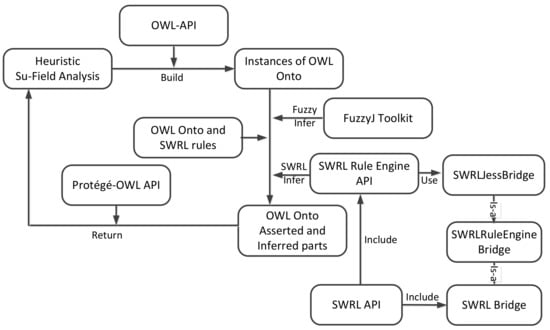
Figure 5.
The implementation of inference for heuristic Su-Field analysis.
The reasoning of heuristic Su-Field analysis includes two classes, namely, fuzzy reasoning for identifying inventive standards and SWRL reasoning for producing heuristic abstract solutions.
Fuzzy reasoning has three main steps: fuzzification, inference and defuzzification, and the chosen means of Executor (TsukamotoRuleExecutor and LarsenProductMaxMinRuleExecutor) and Defuzzifier (MomentDefuzzify, WeightedAverageDefuzzify, MaximumDefuzzify and CenterOfAreaDefuzzify) can influence the performance to different extents. Even though most fuzzy standards have been formalized as standalone fuzzy rules with a individual
Fuzzy Value
for
Antecedent
and
Conclusion, the realization of several fuzzy rules still partially or fully relies on the inference results of other rules, for example, because the fuzzy rules of
Inventive Standard 4.1.3
depends entirely on the fuzzy rules of
Inventive Standard 4.1.2, the fuzzy rules of
Inventive Standard 4.2.4
rely entirely on the fuzzy rules of
Inventive Standard 4.2.3
and the fuzzy rules of
Inventive Standard 4.3.3
rely entirely on the fuzzy rules of
Inventive Standard 4.3.2. Such dependency relationships are automatically enforced, meaning it is possible that the result of executing the first rule will trigger the second rule.
Accordingly, we obtain an inferred value for each fuzzy rule and return the fuzzy standards with inferred values larger than a given threshold as heuristic inventive standards. The user might choose from the crisp standards or the heuristic fuzzy standards to implement the SWRL inference further to generate a heuristic abstract solution. More detailed information about SWRL inference was presented in [8].
5. Case of Study
In order to verify the proposed method, a case study for an engineering design problem in the aerospace industry is introduced. In this case study, the resolution of the case of the “Auguste Piccard’s Stratostat” by the HeuristicSu-FieldAnalysis system is explained in detail.
The problem: A stratostat is designed by Auguste Piccard to measure cosmic rays and atmosphere composition. On the left part of Figure 6, a stratostat is composed of a metallic sphere where 1 bar inside is suspended to an inflatable balloon filled with Helium. When the balloon is placed at the ground altitude, its volume is fixed. However, the higher it goes, the bigger the balloon is (pressure is reduced outside, so closed volume expands). On the top of this balloon, a valve is installed to allow the person inside the sphere to release some Helium and to ensure the balloon will be able to come back down (and also for safety issues of explosion). The valve is connected to the sphere with a long rope, which allows the volume to expand and control the valve (about 10 m of difference). In order to pass the rope through walls, a hole is dug. However, it is necessary to keep the pressure inside the sphere as 1 bar. The rope also needs to be kept free to avoid unwanted opening of the valve.

Figure 6.
The working principle of the “Auguste Piccard’s Stratostat”.
Fuzzy inference for identifying inventive standards: To solve the problem, we begin by constructing the Problem Model. Their basic information should be provided, as illustrated in Figure 7, which includes substance (s), field and the measuring score (s) that triggers the fuzzy rule. It is given in this case “S1-Molecules of air”, “Field-Mechanical field (pressure)” and the list of measured values.
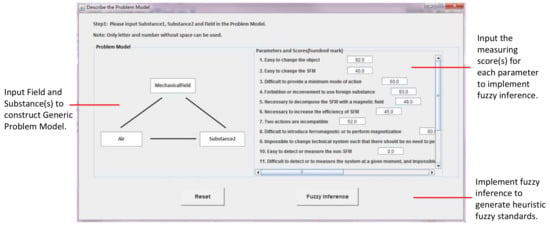
Figure 7.
Describe the Problem Model for the case of the “Auguste Piccard’s Stratostat”.
By implementing fuzzy reasoning based on the input values, the full details of fuzzy reasoning can be obtained, which include the descriptions of antecedent, conclusion and reasoning result, as well as the defuzzified value that measures the applicability of each standard, as shown in Figure 8. Both the number of fuzzy and crisp standards could be changed according to the result of fuzzy reasoning automatically, for example, a standard with an input value equal to
0.0
or
100.0
is considered as a crisp standard because its conditions could be easily estimated to be satisfied or not. Then, a certain threshold (such as
0.75) is given, and all fuzzy standards with defuzzified values larger than the provided threshold are recognized as heuristic standards and are marked with the red color in Figure 9. The heuristic standards obtained may offer several approaches to the solution of the problem, and the most suitable standard should be chosen based on the analysis of a specific case.

Figure 8.
An example of fuzzy Inference result for the case of the “Auguste Piccard’s Stratostat”.
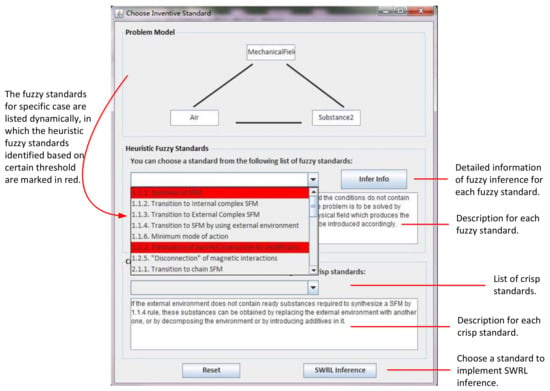
Figure 9.
Choose appropriate inventive standard for the case of the “Auguste Piccard’s Stratostat”.
Based on Su-Field analysis, the first thing is to intensify the conflict. Supposing that a space between the hole wall and the rope is large rather than small, there are no more air molecules inside the sphere than outside, but the rope can be easily moved. Therefore, as shown in Figure 9, the Problem Model built by the user for this case is insufficient (just one substance “S1-molecules of air” instead of two), so choose one of the heuristic fuzzy standards Inventive Standard 1.1.1 to resolve the problem:
- Inventive Standard 1.1.1: Synthesis of Su-Field model.If there is an object that is not easy to change as required, and the conditions do not contain any restrictions on the introduction of substances and fields, the problem is to be solved by synthesizing an SFM: the object is subjected to the action of a physical field that produces the necessary change in the object. The missing elements are introduced accordingly.
SWRL inference for generating the heuristic abstract solution: The results of SWRL reasoning using
Inventive Standard 1.1.1
are shown in Figure 10, yielding the heuristic abstract solution, which is the second substance that acts on the first substance due to the need to introduce a field.
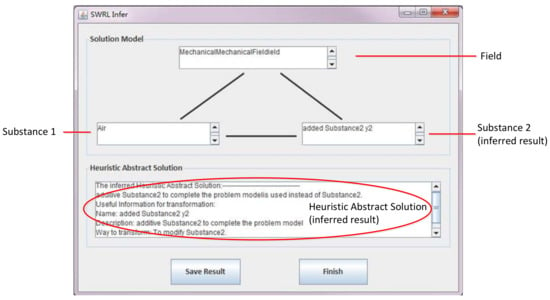
Figure 10.
SWRL Inference result for the case of the “Auguste Piccard’s Stratostat”.
Taking this into account, a new direction to solve this problem is proposed, that is, introducing a material that let the rope go through but not the air. For example, a liquid let solid parts go through but not air, as shown in Figure 11a. However, if a liquid is used at the top of the sphere, it will fall at the bottom, as depicted in Figure 11b.

Figure 11.
Inventive resolution: Introduce a material → Introduce a liquid.
Considering this, the principle of pressure measuring is used, and the inventive concept solution is proposed for this case, as shown in Figure 12. If one side is at outside pressure (left side) and the other one at inside pressure, then h represents the pressure difference. As the stratostat can go very high in the atmosphere, the maximum pressure difference may be 1 bar. Therefore, mercury (1 bar is equal to 76 cm of ) is used here instead of water (1 bar is equal to 13 m of ). This concept solution is an inventive concept since there are no existing widely distributed and produced products in the industry based on this principle (prototypes, patented fabrics, etc.).
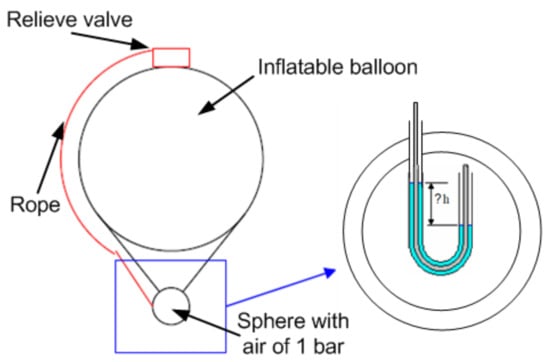
Figure 12.
The inventive concept based on the principle of pressure measuring.
6. Conclusions
Engineering design is a crucial issue in the industry. To facilitate problem solving under complex and multidisciplinary situations, TRIZ has been used to solve inventive engineering problems at different functional levels. As one of the major contributions of TRIZ, Su-Field analysis can lead users to model the physical structure of a problematic system accurately, identify inventive design problems rapidly and find innovative solution to these identified problems efficiently. However, the 76 standard solutions of Su-Field analysis make the implementation of this tool difficult as they contain imprecise information and cannot be fully captured and explained using the Su-Field model. Therefore, a rule-based methodology is proposed to faciliate the Su-Field analysis.
6.1. Contributions to Theory and Practice
In this paper, to facilitate the process of Su-Field analysis for industrial engineering design, a rule-based heuristic methodology is proposed. The created fuzzy rules and SWRL rules can provide additional expressiveness of imprecision and precision to OWL-based knowledge base, and the corresponding fuzzy inference and SWRL inference can generate heuristic abstract solutions for specific problems.There are three contributions of the proposed method that can be summarized: First, establishing a fuzzy analysis ontology to represent inaccurate information and simplify the representation of knowledge in Su-Field analysis leads to a more comprehensive and factualized overall knowledge reasoning process. Second, thanks to fuzzy reasoning, heuristic inventive standards for solving real industrial problems are identified, whose corresponding SWRL rules can be conveniently emitted according to the choice of users, significantly narrowing the searching scope of the inventive standards and ultimately enhancing the performance of knowledge reasoning. Finally, the result of fuzzy reasoning and SWRL reasoning, which includes fuzzy and crisp values, is saved in a newly generated ontology, making the resolution of similar cases based on semantic similarity approaches reusable.The search and reuse of resolutions will help manufactures and system users with seeking solutions for similar engineering design problems faced in the future.
6.2. Research Limitations and Future Directions
Although much progress has been made, this work has several limitations that require further study: (i) The performance of fuzzy inference highly depends on the Fuzzy Sets that construct the antecedents and conclusions of rules. To solve this problem, the optimum combining strategy of Executors, Defuzzification methods and thresholds need to be determined based on the feedback from users. (ii) The input value for fuzzy inference and the way to measure and generate these values needs to be extended to consider more parameters, such as incompatible actions in treatment and measurement. (iii) The completeness of the fuzzy rule library needs to be improved. We aim to add additional rules to the existing ones to improve the overall coverage of the rule base. (iv) To facilitate the reuse of the inferred knowledge, we plan to improve the measurement methods of semantic similarity in the future.
Author Contributions
Conceptualization, W.Y., D.C. and C.Z.-M.; methodology, W.Y.; software, W.Y.; validation, W.Y., Q.C., D.C. and C.Z.-M.; formal analysis, W.Y., D.C. and C.Z.-M.; writing—original draft preparation, W.Y. and Q.C.; writing—review and editing, W.Y., Q.C., L.Z. and Z.J.; supervision, C.Z.-M. and D.C.; project administration, D.C. and C.Z.-M.; funding acquisition, W.Y. and L.Z. All authors have read and agreed to the published version of the manuscript.
Funding
This work is supported by the National Natural Science Foundation of China (No. 62002207, 62072290, 62073201, 12075142) and the Shandong Provincial Natural Science Foundation (No. ZR2020MA102).
Institutional Review Board Statement
Not applicable.
Informed Consent Statement
Not applicable.
Data Availability Statement
Not applicable.
Conflicts of Interest
The authors declare no conflict of interest.
References
- Cavallucci, D.; Fuhlhaber, S.; Riwan, A. Assisting decisions in Inventive Design of complex engineering systems. Procedia Eng. 2015, 131, 975–983. [Google Scholar] [CrossRef] [Green Version]
- Altshuller, G. Creativity as an Exact Science; Gordon and Breach Scientific Publishers: New York, NY, USA, 1984. [Google Scholar]
- Altshuller, G. TRIZ The Innovation Algorithm; Systematic Innovation and Technical Creativity; Technical Innovation Center Inc.: Worcester, MA, USA, 1999. [Google Scholar]
- Cavallucci, D.; Eltzer, T. Parameter network as a means for driving problem solving process. Int. J. Comput. Appl. Technol. 2007, 30, 125–136. [Google Scholar] [CrossRef]
- Zanni-Merk, C.; Cavallucci, D.; Rousselot, F. Use of formal ontologies as a foundation for inventive design studies. Comput. Ind. 2011, 62, 323–336. [Google Scholar] [CrossRef]
- Terninko, J. Su-Field Analysis. TRIZ J. Artic. Arch. 2000. Available online: https://www.metodolog.ru/triz-journal/archives/2000/02/d/article4_02-2000.PDF (accessed on 5 September 2021).
- Cavallucci, D. Word Wide Status of TRIZ Perceptions and User: A Survey of Results. Report at TRIZ Future 2009. 2009. Available online: https://www.semanticscholar.org/paper/World-Wide-status-of-TRIZ-perceptions-and-uses-a-of-Cavallucci/d76aeee1ff8405c3f126054c7c1516b22abfc5da (accessed on 5 September 2021).
- Yan, W.; Zanni-Merk, C.; Cavallucci, D.; Collet, P. An ontology-based approach for using physical effects in inventive design. Eng. Appl. Artif. Intell. 2014, 32, 21–36. [Google Scholar] [CrossRef]
- Yan, W.; Liu, H.; Zanni-Merk, C.; Cavallucci, D. IngeniousTRIZ: An automatic ontology-based system for solving inventive problems. Knowl.-Based Syst. 2015, 75, 52–65. [Google Scholar] [CrossRef]
- Zhang, B.; Zhu, L.; Sun, J.; Zhang, H. Cross-media retrieval with collective deep semantic learning. Multimed. Tools Appl. 2018, 77, 22247–22266. [Google Scholar] [CrossRef]
- Hou, S.; Zhou, S.; Liu, W.; Zheng, Y. Classifying advertising video by topicalizing high-level semantic concepts. Multimed. Tools Appl. 2018, 77, 25475–25511. [Google Scholar] [CrossRef]
- Zhu, L.; Huang, Z.; Li, Z.; Xie, L.; Shen, H. Exploring Auxiliary Context: Discrete Semantic Transfer Hashing for Scalable Image Retrieval. IEEE Trans. Neural Netw. Learn. Syst. 2018, 29, 5264–5276. [Google Scholar] [CrossRef] [PubMed] [Green Version]
- Cui, C.; Liu, H.; Lian, T.; Nie, L.; Zhu, L.; Yin, Y. Distribution-oriented aesthetics assessment with semantic-aware hybrid network. IEEE Trans. Multimed. 2018, 21, 1209–1220. [Google Scholar] [CrossRef]
- Vanzo, A.; Croce, D.; Bastianelli, E.; Basili, R.; Nardi, D. Grounded language interpretation of robotic commands through structured learning. Artif. Intell. 2020, 278, 103181. [Google Scholar] [CrossRef]
- Cohen, Y.; Reich, Y. Biomimetic Design Method for Innovation and Sustainability; Chapter Functional Patterns; Springer: Berlin/Heidelberg, Germany, 2016. [Google Scholar]
- Bultey, A.; Yan, W.; Zanni-Merk, C. A proposal of a systematic and consistent substance-field analysis. Procedia Eng. 2015, 131, 701–710. [Google Scholar] [CrossRef] [Green Version]
- Bultey, A.; Beuvron, F.D.; Rousselot, F. A substance-field ontology to support the TRIZ thinking approach. Int. J. Comput. Appl. Technol. 2007, 30, 113–124. [Google Scholar] [CrossRef]
- Zadeh, L. The concept of a linguistic variable and its application to approximate reasonning—II. Inf. Sci. 1975, 8, 301–357. [Google Scholar] [CrossRef]
- Luo, C.; Tan, C.; Zheng, Y. Long-term prediction of time series based on stepwise linear division algorithm and time-variant zonary fuzzy information granules. Int. J. Approx. Reason. 2019, 108, 38–61. [Google Scholar] [CrossRef]
- Wang, H.; He, D.; Shen, J.; Zheng, Z.; Yang, X.; Au, M. Fuzzy matching and direct revocation: A new CP-ABE scheme from multilinear maps. Soft Comput. 2018, 22, 2267–2274. [Google Scholar] [CrossRef]
- Bobillo, F.; Straccia, U. Fuzzy ontology representation using OWL 2. Int. J. Approx. Reason. 2011, 52, 1073–1094. [Google Scholar] [CrossRef] [Green Version]
- Wlodarczyk, T.; O’Connor, M.; Rong, C.; Musen, M. SWRL-F—A fuzzy logic extension of the semantic web rule language. In Proceedings of the 6th International Conference on Uncertainty Reasoning for the Semantic Web, Shanghai, China, 7 November 2010; Volume 654, pp. 1–9. [Google Scholar]
- Pan, J.; Stamou, G.; Tzouvaras, V.; Horrocks, I. f-SWRL: A Fuzzy Extension of SWRL. In Artificial Neural Networks: Formal Models and Their Applications—ICANN 2005; Springer: Berlin/Heidelberg, Germany, 2005; pp. 829–834. [Google Scholar]
- Lee, C.H.; Chen, C.H.; Li, F.; Shie, A.J. Customized and knowledge-centric service design model integrating case-based reasoning and TRIZ. Expert Syst. Appl. 2020, 143, 113062. [Google Scholar] [CrossRef]
- Wu, Y.; Zhou, F.; Kong, J. Innovative design approach for product design based on TRIZ, AD, fuzzy and Grey relational analysis. Comput. Ind. Eng. 2020, 140, 106276. [Google Scholar] [CrossRef]
- Mao, X.; Zhang, X.; AbouRizk, S. Generalized solutions for Su-Field analysis. TRIZ J. Artic. Arch. 2007. Available online: https://www.researchgate.net/publication/257242616_Generalized_Solutions_for_Su-Field_Analysis (accessed on 5 September 2021).
- Savransky, S. Engineering of Creativity: Introduction to TRIZ Methodology of Inventive Problem Solving; CRC Press: Boca Raton, FL, USA, 2000. [Google Scholar]
Publisher’s Note: MDPI stays neutral with regard to jurisdictional claims in published maps and institutional affiliations. |
© 2022 by the authors. Licensee MDPI, Basel, Switzerland. This article is an open access article distributed under the terms and conditions of the Creative Commons Attribution (CC BY) license (https://creativecommons.org/licenses/by/4.0/).